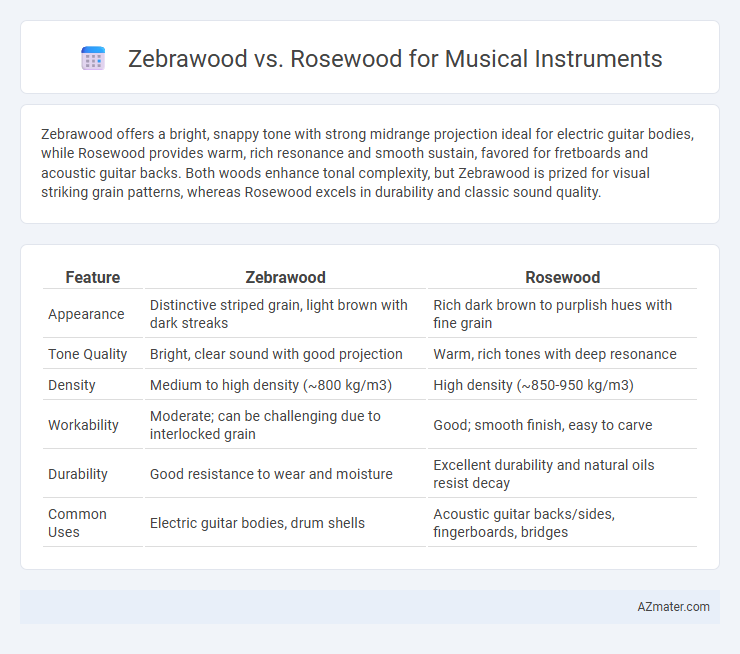Zebrawood offers a bright, snappy tone with strong midrange projection ideal for electric guitar bodies, while Rosewood provides warm, rich resonance and smooth sustain, favored for fretboards and acoustic guitar backs. Both woods enhance tonal complexity, but Zebrawood is prized for visual striking grain patterns, whereas Rosewood excels in durability and classic sound quality.
Table of Comparison
| Feature | Zebrawood | Rosewood |
|---|---|---|
| Appearance | Distinctive striped grain, light brown with dark streaks | Rich dark brown to purplish hues with fine grain |
| Tone Quality | Bright, clear sound with good projection | Warm, rich tones with deep resonance |
| Density | Medium to high density (~800 kg/m3) | High density (~850-950 kg/m3) |
| Workability | Moderate; can be challenging due to interlocked grain | Good; smooth finish, easy to carve |
| Durability | Good resistance to wear and moisture | Excellent durability and natural oils resist decay |
| Common Uses | Electric guitar bodies, drum shells | Acoustic guitar backs/sides, fingerboards, bridges |
Introduction to Zebrawood and Rosewood
Zebrawood, known for its striking light brown base with dark brown streaks, offers durability and a bright tonal quality favored in musical instruments like guitars and drums. Rosewood, prized for its rich, warm tones and smooth texture, is a traditional choice for fingerboards and soundboards, enhancing resonance and sustain. Both woods provide unique acoustic properties and aesthetic appeal, influencing sound quality and instrument longevity.
Botanical Origins and Availability
Zebrawood, botanically known as Microberlinia brazzavillensis, is native to West Africa and characterized by its striking striped grain pattern, making it a visually distinctive choice for musical instruments. Rosewood, predominantly from the Dalbergia genus, primarily grows in Brazil, India, and Madagascar, valued for its rich tonal properties and dense, dark grain. Availability of zebrawood is more limited due to its regional growth and sustainability regulations, while rosewood faces restrictions under CITES, affecting its supply and use in instrument manufacturing.
Visual Appearance and Aesthetics
Zebrawood features striking, contrasting light and dark stripes that create a bold, exotic look, making it highly desirable for visually distinctive musical instruments. Rosewood offers rich, deep reddish-brown hues with intricate grain patterns, providing a classic, warm aesthetic often preferred for traditional string instruments. Both woods enhance instrument beauty, but Zebrawood stands out for bold patterns, while Rosewood emphasizes refined elegance.
Tonal Characteristics and Sound Quality
Zebrawood produces a bright, focused tone with crisp highs and clear mids ideal for electric guitar bodies and drum shells, offering excellent projection and articulation. Rosewood is prized for its rich, warm sound with deep bass resonance and complex overtones, making it a preferred choice for acoustic guitar fretboards and backs. The tonal qualities of Zebrawood emphasize clarity and punch, while Rosewood delivers a balanced, full-bodied sound favored in diverse musical styles.
Workability and Craftsmanship
Zebrawood offers excellent workability with a coarse texture and medium density, allowing for smooth shaping and detailed carving in musical instruments, making it ideal for both beginners and skilled luthiers. Rosewood, known for its fine grain and natural oils, provides superior craftsmanship potential by enhancing durability and rich tonal qualities, despite being slightly harder to work with due to its density. Both woods contribute unique aesthetic and acoustic properties, but Rosewood is often preferred for high-end instruments requiring intricate detail and long-lasting performance.
Durability and Longevity
Zebrawood offers moderate durability with a unique striped appearance, but it is less dense and more prone to wear compared to rosewood, which is renowned for its exceptional hardness and resistance to moisture. Rosewood's dense grain structure ensures greater longevity for musical instruments, making it a preferred choice for fingerboards and bridges. Instruments constructed with rosewood withstand frequent use and environmental changes better, enhancing both durability and tonal stability over time.
Common Uses in Musical Instruments
Zebrawood is prized in musical instrument construction for its striking striped appearance and durability, commonly used in guitar bodies, fingerboards, and drum shells to provide both aesthetic appeal and tonal clarity. Rosewood, favored for its rich, warm tones and smooth texture, is extensively employed in fingerboards, bridges, and acoustic guitar backs, enhancing resonance and sustain. Both woods contribute distinct visual and acoustic qualities, making them popular choices for high-quality stringed instruments and percussion.
Environmental Impact and Sustainability
Zebrawood, sourced primarily from West African tropical forests, is often less regulated but faces rising deforestation concerns, impacting its sustainability for musical instruments. Rosewood, especially species like Brazilian Rosewood, is heavily protected under CITES due to overharvesting, significantly restricting its availability and encouraging illegal logging. Choosing responsibly certified Zebrawood or alternative sustainably harvested rosewoods can mitigate environmental impact while maintaining tonal quality for guitars and other stringed instruments.
Price Comparison and Market Value
Zebrawood and Rosewood differ significantly in price and market value for musical instruments, with Rosewood generally commanding higher prices due to its rich tonal qualities and rarity. Rosewood's value is bolstered by regulations like CITES restrictions, increasing its exclusivity and cost, whereas Zebrawood offers a more affordable alternative with visually unique grain patterns but less resonance. Market demand for Rosewood remains strong among professional instrument makers, while Zebrawood appeals to budget-conscious musicians seeking distinctive aesthetics without the premium price tag.
Choosing the Right Wood for Your Instrument
Choosing between zebrawood and rosewood for musical instruments depends on tonal qualities and aesthetic preferences. Zebrawood offers a bright, articulate sound with a striking striped grain that enhances instrument visual appeal, while rosewood is favored for its warm, rich tones and natural durability ideal for fretboards and soundboards. Consider rosewood's superior resonance and traditional use in classical guitars versus zebrawood's unique look and sharper sound profile when selecting the wood that matches your playing style.

Infographic: Zebrawood vs Rosewood for Musical Instrument
 azmater.com
azmater.com